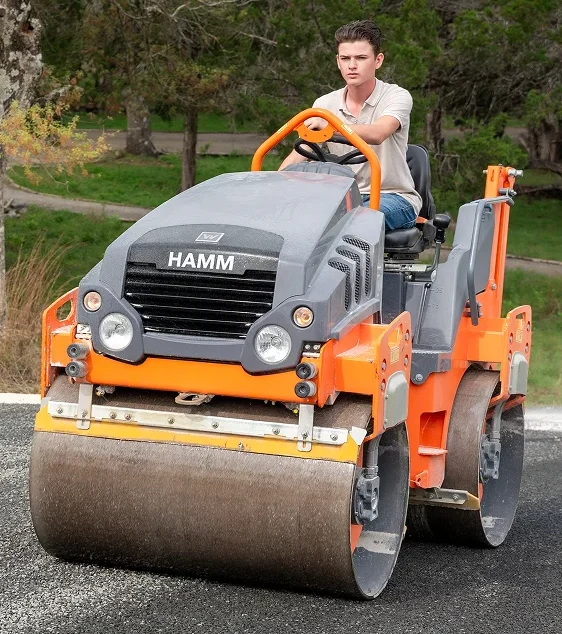Ever watched a fresh asphalt paving project and wondered why the crew works so quickly? It’s not just about speed asphalt temperature is important to the success of the job. From residential driveways in Bulverde to large-scale road paving across South Texas, keeping the temperature of asphalt in check ensures a long-lasting surface that won’t crack, crumble, or deteriorate prematurely.
Whether it’s asphalt paving for a new parking lot or a simple repair, the temperature of the asphalt mix can make or break the entire project. The importance of temperature in asphalt is often underestimated, but seasoned contractors like C. Brooks Paving understand that maintaining the proper temperature from plant to pavement is crucial.
The Temperature Needs of Asphalt
Paving with hot-mix asphalt involves precise heat ranges. If the temperature in asphalt paving isn’t correct, it can affect compaction, durability, and the overall installation quality. Here’s a breakdown of the critical stages and temperatures to watch.
1. Mixing at the Asphalt Plant
- Ideal temperature range: between 275°F and 325°F
- Maintains the asphalt mix consistency
- Prevents burning of binder and oils
2. Transport to the Job Site
- Asphalt must stay above 260°F
- Trucks are tarped or insulated to prevent heat loss
- If asphalt cools too quickly, it may harden before installation
3. Laying and Compaction
- Begin compaction around 290°F
- Work must finish before the asphalt temperature drops below 185°F
- Cooler material leads to poor compaction and weak asphalt pavement
Why Temperature Affects Asphalt Longevity
Let’s break down how temperature plays a significant role in each step of an asphalt paving project.
During Mixing
- If the temperature of the asphalt is too low, it won’t bind
- Too hot, and the asphalt can lose its essential oils, reducing longevity
During Transport
- Ambient temperature and ground temperature influence how fast asphalt will cool
- Delays in delivery mean the asphalt may drop below the optimal temperature
During Installation
- Cold or improperly heated asphalt won’t adhere to the base
- Crews must act fast to lay asphalt before it stiffens
During Compaction
- Cold temperatures result in poor compaction
- Without proper temperature, the asphalt may develop potholes or cracks early

Risks of Using Cold Asphalt
Not managing the temperature of the mix properly can lead to:
- Weak bonding to the base layer
- Air pockets that trap moisture
- Early-stage cracking and potholes
- Reduced durability and poor surface performance
- costly repair and cleaning issues down the line
Seasonal Factors in South Texas Affecting Asphalt Paving
Summer
- Hot asphalt benefits from high air temperature
- But excessive heat can interfere with compaction timing
- Crews prefer early morning paving project schedules
Winter
- Colder environmental conditions shorten the paving window
- Crews may use smaller loads or heating equipment
- Some days may not meet the specific temperature required
Rain and Humidity
- Moisture impacts adhesion and causes poor installation
- Humidity can cool hot-mix asphalt faster than expected
How C. Brooks Paving Ensures Proper Temperature Management
We don’t gamble with temperature. Instead, we plan every detail for a successful asphalt outcome.
Temperature Management Steps:
- Use insulated trucks from the asphalt plant to the site
- Monitor temperatures constantly for both asphalt production and placement
- Schedule jobs based on ideal temperature range and local forecasts
- Apply proper compaction techniques while the mix is still hot
- Avoid cold temperatures that compromise strength
This approach ensures a high-quality, long-lasting surface that can stand the test of time.

Benefits of Maintaining the Correct Asphalt Temperature
When you install asphalt at the correct temperature, you’ll enjoy:
- Strong adhesion to the base layer
- Smooth, even asphalt surfaces
- Reduced need for early repair or cleaning
- Fewer imperfections and improved drainage
- Improved durability and longer longevity of asphalt
When to Schedule Your Asphalt Paving Project in Bulverde
Plan your next asphalt paving job with weather in mind.
Best Paving Conditions:
- Daytime temps between 70°F and 90°F
- Dry weather 24 hours before and after
- Early mornings to avoid rapid cooling
- Avoid days below 50°F to maintain compaction quality
Always consult with a reliable contractor who understands temperature variations like C. Brooks Paving.
Final Thoughts: Temperature Is the Backbone of Every Successful Asphalt Job
Hot does asphalt need to be? Just right. Anything less, and the entire structure is at risk.
At C. Brooks Paving, we understand how temperature in asphalt paving influences every inch of your driveway, road, or parking lot paving. Our team ensures that every type of asphalt mix is installed at the right asphalt temperature for reliable results that last for years.
Frequently Asked Questions
Q: 1 How hot is asphalt when applied?
A: It’s typically between 275 and 300 degrees Fahrenheit to allow proper flow and compaction.
Q: 2 What happens if the asphalt is too cool?
A: Cold asphalt can’t be compacted effectively and will likely crack, ravel, or wear down quickly.
Q: Can I pave during winter in South Texas?
A: Yes, but conditions need to meet the minimum ambient temperature. Fewer working hours mean tight scheduling.
Q: Why is temperature monitoring critical?
A: Because the temperature of asphalt important for bonding, strength, and overall surface quality. Temperature plays a major role from start to finish.





